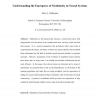Free Online Productivity Tools
i2Speak
i2Symbol
i2OCR
iTex2Img
iWeb2Print
iWeb2Shot
i2Type
iPdf2Split
iPdf2Merge
i2Bopomofo
i2Arabic
i2Style
i2Image
i2PDF
iLatex2Rtf
Sci2ools
COGSCI
2007
2007
Understanding the Emergence of Modularity in Neural Systems
: Modularity in the human brain remains a controversial issue, with disagreement over the nature of the modules that exist, and why, when and how they emerge. It is a natural assumption that modularity offers some form of computational advantage, and hence evolution by natural selection has translated those advantages into the kind of modular neural structures familiar to cognitive scientists. However, simulations of the evolution of simplified neural systems have shown that, in many cases, it is actually non-modular architectures that are most efficient. In this paper, the relevant issues are discussed and a series of simulations are presented that reveal crucial dependencies on the details of the learning algorithms and tasks that are being modelled, and the importance of taking into account known physical brain constraints, such as the degree of neural connectivity. A pattern is established which provides one explanation of why modularity should emerge reliably across a range of neu...
| Added | 12 Dec 2010 |
| Updated | 12 Dec 2010 |
| Type | Journal |
| Year | 2007 |
| Where | COGSCI |
| Authors | John A. Bullinaria |
Comments (0)

